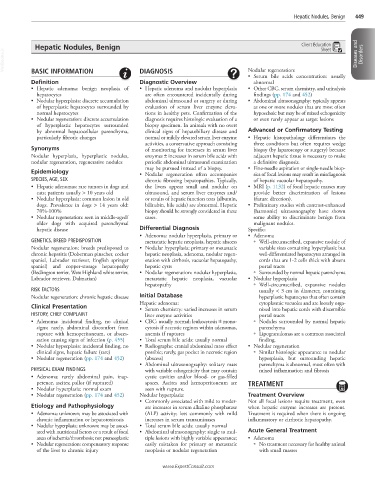Page 919 - Cote clinical veterinary advisor dogs and cats 4th
P. 919
Hepatic Nodules, Benign 449
Hepatic Nodules, Benign Client Education
Sheet
VetBooks.ir Diseases and Disorders
Nodular regeneration:
BASIC INFORMATION
DIAGNOSIS
• Serum bile acids concentration: usually
Definition Diagnostic Overview abnormal
• Hepatic adenoma: benign neoplasia of • Hepatic adenoma and nodular hyperplasia • Other CBC, serum chemistry, and urinalysis
hepatocytes are often encountered incidentally during findings (pp. 174 and 452)
• Nodular hyperplasia: discrete accumulation abdominal ultrasound or surgery or during • Abdominal ultrasonography: typically appears
of hyperplastic hepatocytes surrounded by evaluation of serum liver enzyme eleva- as one or more nodules that are most often
normal hepatocytes tions in healthy pets. Confirmation of the hypoechoic but may be of mixed echogenicity
• Nodular regeneration: discrete accumulation diagnosis requires histologic evaluation of a or even rarely appear as target lesions
of hyperplastic hepatocytes surrounded biopsy specimen. In animals with no overt
by abnormal hepatocellular parenchyma, clinical signs of hepatobiliary disease and Advanced or Confirmatory Testing
particularly fibrotic changes normal or mildly elevated serum liver enzyme • Hepatic histopathology differentiates the
activities, a conservative approach consisting three conditions but often requires wedge
Synonyms of monitoring for increases in serum liver biopsy (by laparoscopy or surgery) because
Nodular hyperplasia, hyperplastic nodules, enzymes ± increases in serum bile acids with adjacent hepatic tissue is necessary to make
nodular regeneration, regenerative nodules periodic abdominal ultrasound examination a definitive diagnosis.
may be pursued instead of a biopsy. • Fine-needle aspiration or single-needle biop-
Epidemiology • Nodular regeneration often accompanies sies of focal lesions may result in misdiagnosis
SPECIES, AGE, SEX chronic fibrosing hepatopathies. Typically, of hepatic vacuolar hepatopathy.
• Hepatic adenomas: rare tumors in dogs and the livers appear small and nodular on • MRI (p. 1132) of focal hepatic masses may
cats; patients usually > 10 years old ultrasound, and serum liver enzymes and/ provide better discrimination of lesions
• Nodular hyperplasia: common lesion in old or results of hepatic function tests (albumin, (future direction).
dogs. Prevalence in dogs > 14 years old: bilirubin, bile acids) are abnormal. Hepatic • Preliminary studies with contrast-enhanced
70%-100% biopsy should be strongly considered in these (harmonic) ultrasonography have shown
• Nodular regeneration: seen in middle-aged/ cases. some ability to discriminate benign from
older dogs with acquired parenchymal malignant nodules.
hepatic disease Differential Diagnosis Specific:
• Adenoma: nodular hyperplasia, primary or • Adenoma
GENETICS, BREED PREDISPOSITION metastatic hepatic neoplasia, hepatic abscess ○ Well-circumscribed, expansive nodule of
Nodular regeneration: breeds predisposed to • Nodular hyperplasia: primary or metastatic variable sizes containing hyperplastic but
chronic hepatitis (Doberman pinscher, cocker hepatic neoplasia, adenoma, nodular regen- well-differentiated hepatocytes arranged in
spaniel, Labrador retriever, English springer eration with cirrhosis, vacuolar hepatopathy, cords that are 1-2 cells thick with absent
spaniel) and copper-storage hepatopathy hepatic cysts portal tracts
(Bedlington terrier, West Highland white terrier, • Nodular regeneration: nodular hyperplasia, ○ Surrounded by normal hepatic parenchyma
Labrador retriever, Dalmatian) metastatic hepatic neoplasia, vacuolar • Nodular hyperplasia
hepatopathy ○ Well-circumscribed, expansive nodules
RISK FACTORS usually < 3 cm in diameter, containing
Nodular regeneration: chronic hepatic disease Initial Database hyperplastic hepatocytes that often contain
Hepatic adenoma: cytoplasmic vacuoles and are loosely orga-
Clinical Presentation • Serum chemistry: varied increases in serum nized into hepatic cords with discernible
HISTORY, CHIEF COMPLAINT liver enzyme activities portal tracts
• Adenoma: incidental finding, no clinical • CBC: usually normal; leukocytosis ± mono- ○ Nodules surrounded by normal hepatic
signs; rarely, abdominal discomfort from cytosis if necrotic regions within adenomas, parenchyma
rupture with hemoperitoneum, or absces- anemia if ruptures ○ Lipogranulomas are a common associated
sation causing signs of infection (p. 455) • Total serum bile acids: usually normal finding.
• Nodular hyperplasia: incidental finding, no • Radiographs: cranial abdominal mass effect • Nodular regeneration
clinical signs, hepatic failure (rare) possible; rarely, gas pocket in necrotic region ○ Similar histologic appearance to nodular
• Nodular regeneration (pp. 174 and 452) (abscess) hyperplasia, but surrounding hepatic
• Abdominal ultrasonography: solitary mass parenchyma is abnormal, most often with
PHYSICAL EXAM FINDINGS with variable echogenicity that may contain mixed inflammation and fibrosis
• Adenoma: rarely abdominal pain, inap- cystic cavities and/or blood- or gas-filled
petence, ascites; pallor (if ruptured) spaces. Ascites and hemoperitoneum are TREATMENT
• Nodular hyperplasia: normal exam seen with rupture.
• Nodular regeneration (pp. 174 and 452) Nodular hyperplasia: Treatment Overview
• Commonly associated with mild to moder- Not all focal lesions require treatment, even
Etiology and Pathophysiology ate increases in serum alkaline phosphatase when hepatic enzyme increases are present.
• Adenoma: unknown; may be associated with (ALP) activity; less commonly with mild Treatment is required when there is ongoing
chronic inflammation or hepatotoxicosis increases in serum transaminases inflammatory or cirrhotic hepatopathy.
• Nodular hyperplasia: unknown; may be associ- • Total serum bile acids: usually normal
ated with nutritional factors or a result of focal • Abdominal ultrasonography: single to mul- Acute General Treatment
areas of ischemia/thrombosis; not preneoplastic tiple lesions with highly variable appearance; • Adenoma
• Nodular regeneration: compensatory response easily mistaken for primary or metastatic ○ No treatment necessary for healthy animal
of the liver to chronic injury neoplasia or nodular regeneration with small masses
www.ExpertConsult.com

